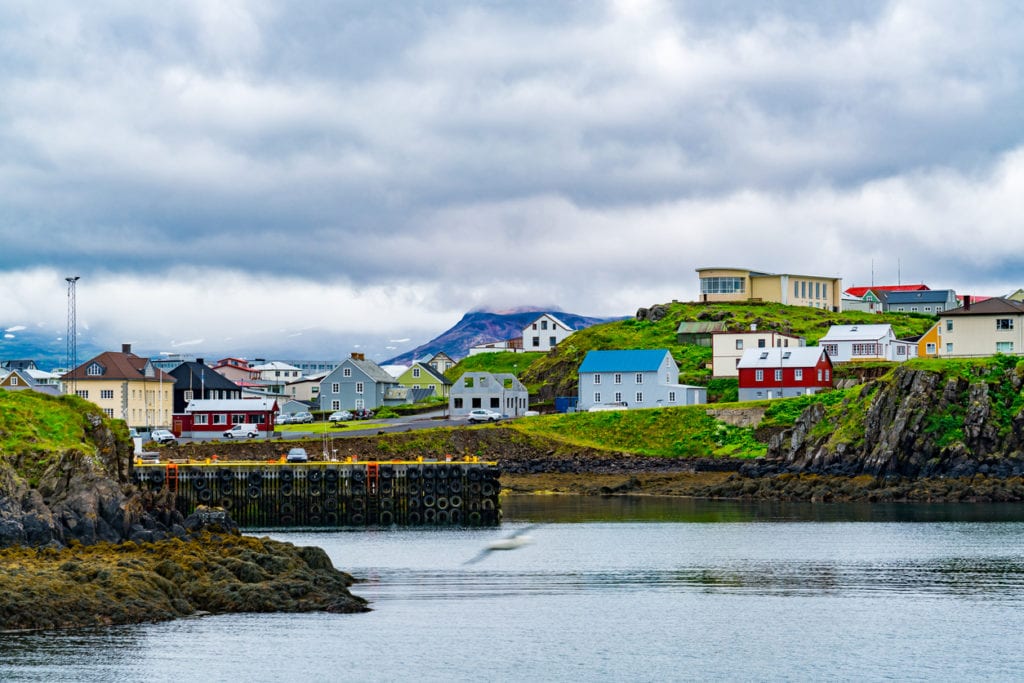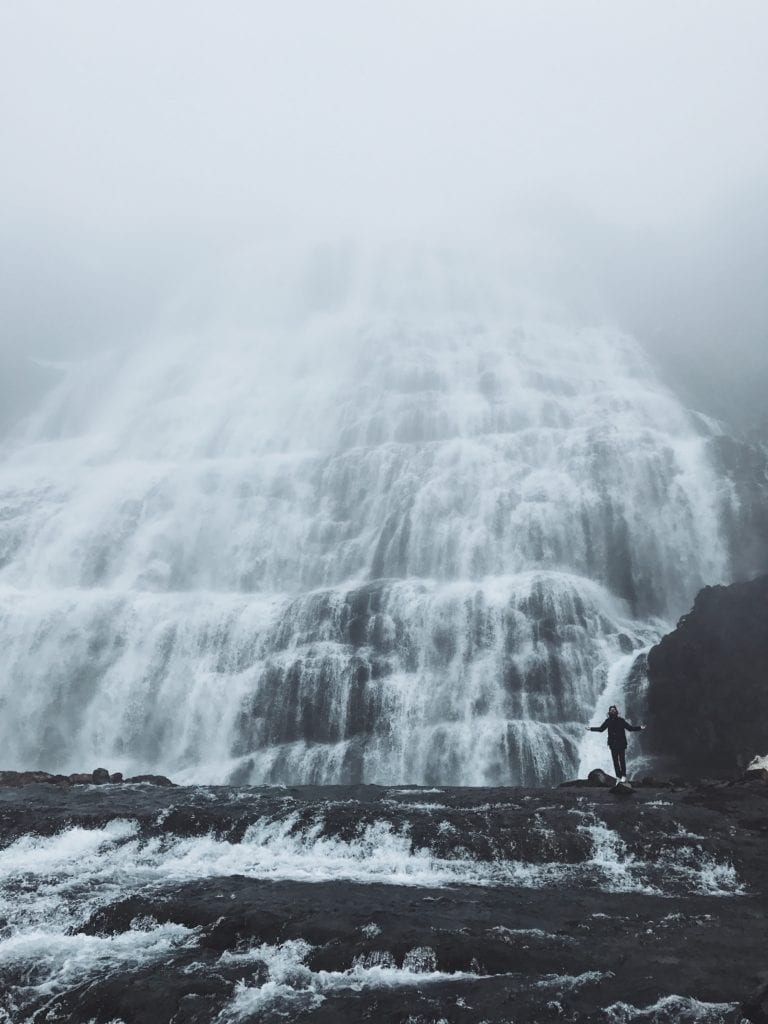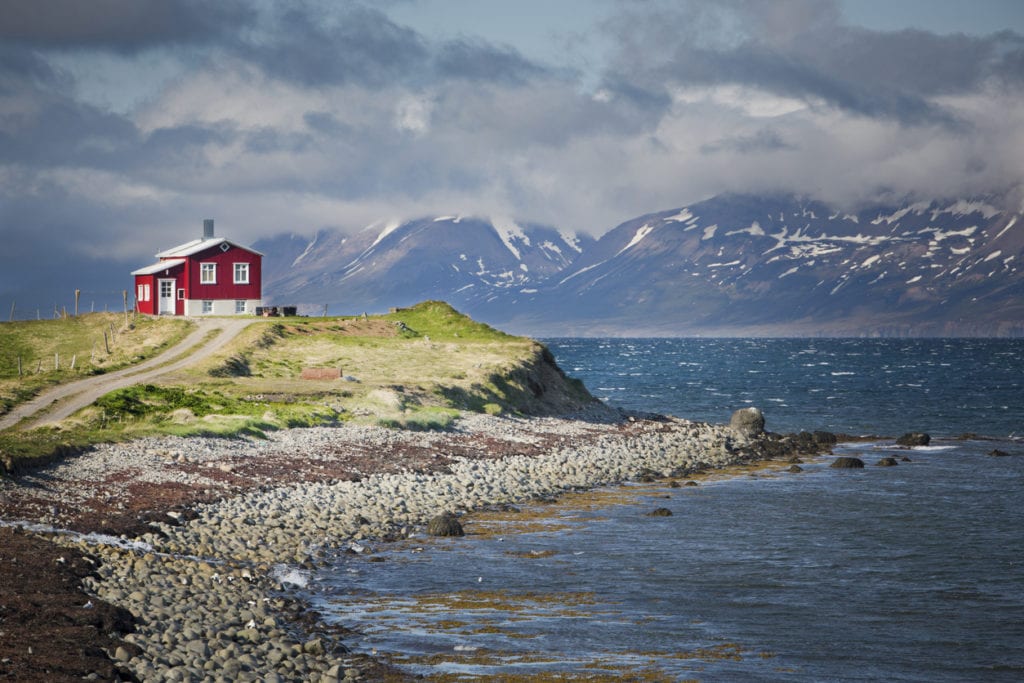The Icelandic Westfjords’ beauty lies in its strange balance of rugged drama and quiet calm. This wild peninsula — separated by an isthmus from the mainland — is studded with nature at her most intense. Mountains, fjords, waterfalls, beaches, wildlife, and a third of the coastland in Iceland. But despite the dramatic nature of the landscape, the Westfjords maintain a tranquility that comes from being one of the least touristy areas in Iceland (even in the summer, only around 12% of tourists make it out to the Westfjords in Iceland).
When you visit the Westfjords in Iceland, you will be overwhelmed by your proximity to nature. Out here, there is nothing between you and the authentic experience of a mostly-unchanged landscape. There are no large cities out here in the westernmost part of Iceland — in fact, the largest town Ísafjörður has only 2,600 inhabitants. Let’s take a closer look at traveling this peninsula: its history, its towns, and its rugged natural splendor.
A History of the Westfjords – And How to Get There
According to the official travel guide to the Westfjords in Iceland, this peninsula was first settled first by Vikings. The remote nature of the Westfjords meant that its residents quickly took the fishing as a way of life — a fact that will be evident if you visit the small fishing villages along the coast. In the winter, harsh conditions often spelled disaster for men who took their boats out on the choppy, icy waves. But in other ways, this remoteness from the rest of Iceland has been an immunizing force throughout history: people in the Westfjords in Iceland avoided epidemics and famines that plagued the rest of Iceland.
To this day, only around 7,000 individuals call the Westfjords home. And these hardy individuals still brave harsh winters and impassable roads. Though there are now schools and hospitals in the Westfjords, remnants of traditional culture remain. Farmers still herd flocks of sheep over the craggy landscape, and people in the small town of Reykhólar still whisper about the nearby elves that hold a trading post in unique Bjartmarssteinn rock formations.
Getting to the Westfjords from Reykjavik
It’s simple to get to the Westfjords from Reykjavik.
- From Reykjavik, follow Road #1 through the town of Bifrost.
- From Bifrost, turn onto Road #60.
- Cross the bridge across Gilsfjörður.
- Stick to route 60 to begin a clockwise journey around the Westfjords Ring Road
- Alternately, if you’re visiting in winter and heading straight to Ísafjörður, take road 61 toward Hólmavík/
Once you’re in, you will find yourself traversing the Westfjords’ Ring Road, which winds around fjords, hillsides, mountains, and valleys to make for an incredible drive. Westfjords’ small towns are located in coastal areas, small bubbles of human activity amidst a mostly wild landscape. (Remember that some of the roads are impossible to traverse in the wintertime, so plan your journey accordingly. If traveling in the winter, visit road.is for road information.)
A Journey Through the Westfjords in Iceland — Villages, Culture, and Natural Beauty

Prepare to be stunned. First of all, the many fjords themselves, deep blue and breathtaking, are enough to make the Westfjords unforgettable. Powerful waterfalls splash against mossy green backdrops. The bright, summery green of the valleys, the deep silhouettes of the mountains, the striking height of the cliffs, the grandeur of the natural reserves — all these attributes make the Westfjords unforgettable. But it’s not all rugged and fierce: here, golden sands touch the soft foam of the sea, and small villages follow the lengthy coastline.
Each of these villages has a unique and unforgettable feeling. Though you can choose which towns you’ll wish to visit as you start your journey at the southwesternmost corner, we’ve outlined a route that can take you all around the perimeter of the Westfjords. We’ve highlighted towns and natural wonders along the way to help you plan your journey:
Reykhólar (Road 606)
This village offers a glimpse into a unique ecosystem of ponds and marshland. Reykhólar is famed for its bird-watching and is home to a museum that highlights the gifts of nature. Also, it’s home to the Sjávarsmidjan Spa, where you can enjoy a traditional seaweed bath.
Patreksfjörður (Road 63)
This is the largest town in the southern Westfjords. It is home to some of the most incredible natural wonders in the area. Near Patreksfjörður, you will find:
Látrabjarg cliffs — You can access these breathtaking cliffs by car and then walk along the clifftops. Known as one of the largest bird cliffs in all of Europe, prepare to be stunned by the steep drama of the cliffs paired with an incredible diversity of bird life.
Rauðasandur beach — Don’t miss this beautiful beach, which boasts sands in shifting colors and highlights the Westfjords’ beautiful ocean views.
Dynjandi waterfall — This famous sparkling waterfall is a must-see; you can walk up to the top of the waterfall in merely 15 minutes.

Tálknafjörður (Road 63)
There are approximately 300 year-round inhabitants in the town of Tálknafjörður, which is near the geothermal hot tub, Pollurinn. Like everywhere in the Westfjords, there are plenty of hiking trails into nature around this village that you can explore.
Bíldudalur (Road 63)
This beautiful town, tucked beside the breathtaking, famous Arnarfjörður fjord is a place of myth and legend. It’s said that sea monsters live in this fjord — visit the local Sea Monster Museum to learn more. If you stop in Bíldudalur (which is only advisable in the summer months, due to the mountain roads nearby), be sure to check out the Melodies of the Past exhibit. It celebrates Iceland’s folk music legacy.
Þingeyri (Road 60)
Home to a very tiny post office, Þingeyri is on the deep blue, breathtaking fjord of Dýrafjörður. Culture-lovers will enjoy visiting the blacksmith factory-turned-museum, and learning about Gísli Súrsson of the Saga of Gisli, a warrior of the 10th century who made this town his home. This seaside village, aside from showcasing the outstanding views of the fjord, is near to the Alps of the Westfjords in Iceland, so-called due to their snow-dusted alpine tops. This is where you’ll find Kaldbakur, the tallest mountain in the Westfjords.
Flateyri (Road 64)
Flateyri has been a trading post since 1782, eventually becoming a whaling base in the 19th century. There’s a beautiful bookstore/museum to enjoy in this town, a swimming pool, and (of course) some natural wonders nearby:
Holt Beach — Iceland is known for its multi-colored beaches, and the golden sand of Holt Beach is particularly resplendent, calm, and peaceful.
Ingjaldssandur — If you are looking for one of the most gorgeous drives you’ll ever take in your life, you need to explore the incredible and lush valley of Ingjaldssandur.
Suðureyri (Road 65)
If you stop in Suðureyri, check out the unique Lagoon, where you can stare in the depths of the water and feed fish from your own hands. There are hiking trails all around this small village.
Bolungarvík (Road 61)
This city, situated in a beautiful cove, is the most northern town in the Westfjords. You’ll find all sorts of modern amenities here, including a gas station, a nearby golf course, and an indoor swimming pool. You can also visit the Natural History Museum, which highlights animal and geological features, including the jaw of a blue whale.
While you’re around here, enjoy the incredible views from atop Bolafjall Mountain. From Bolungarvik, you can drive up the mountain to the radio station to take in the views (keep in mind that this is only open from mid-June to September at the latest due to road conditions).
Hnífsdalur (Road 61)
Stop by this quiet village if you want to be astounded by the lush and verdant Hnífsdalur Valley, which you can traverse via trails.
Ísafjörður (Road 61)
This, the largest town in the Westfjords (and the regional capital), is not to be missed. With a trading post dating back to the 16th century, this is where you will find the most modern amenities in the Westfjords: hospital, schools, a small college, and plenty of restaurants. Here you’ll find the Westfjords Heritage Museum which offers a glimpse into the maritime history of this area. For more culture, check out The Museum House, which has art, photography, and a library.
Near Ísafjörður is one of the most incredible places in Westfjord. Described by the Lonely Planet as “one of Europe’s last true wilderness areas“, the Hornstrandir Nature Reserve is a classic, rugged wilderness. Here you’ll see fjords, glaciers, and tundra. It is a truly special place to hike or even camp (in the summer months).
Súðavík (Road 61)
This small village was damaged by an avalanche in 1995, and since then the town has remained divided into two distinct areas, the old and the new. This area is remarkable because it is part of the 8-fjord system of Ísafjarðardjúp. It’s special for its diversity of wildlife, the mountainous region scattered with fjords highlighting seals and whales along your route.
It’s also close by the incredible Valagil Ravine, a lava-crafted ravine which is accessible by a footpath. Once there, you’ll marvel not only in the rugged ravine itself, but the waterfall that springs from it.
Hólmavík (Road 61)
This unique village has an incredible Museum of Sorcery & Witchcraft dedicated to the tragic history of witch-hunting in Iceland. It’s also home to the quaint Sheep Farming Museum. Nearby, there are three striking rock pillars, said to be mythic trolls whose goal was to sever Westfjords from the Iceland mainland!
Drangsnes (Road 645)
This small village allows access to Grimsey Island a mere 10-minute boat ride away. Grimsey rises out of the ocean like a mythical land and is an incredible place to enjoy the quietude of nature and the bird life.
There is So Much Beauty in the Westfjords in Iceland

Though the journey we’ve described touches on almost all the small villages in the Westfjords, keep in mind that you can make this trip completely customized to your needs. Park yourself in the largest city, Ísafjörður, and explore from there. Take advantage of the hundreds of hiking trails that pepper the Westfjords in Iceland.
Check out the incredible Drangajökull glacier, the only glacier in the Westfjords. Make your way to the incredible Vatnsfjörður nature reserve, which houses an incredible diversity of plants and animals and offers a glimpse into an utterly unspoiled wilderness. Follow the course of the Watertrail and enjoy all the remote pools scattered through the Westfjords.
Learn More About Westfjords in Iceland
We want to be a part of your amazing journey into the Westfjords. To do this, we will provide you with the perfect vehicle to traverse this rugged terrain. Please see our wide selection of rental cars to get started. In addition, check out our travel stories — sure to inspire you for your next adventure in Iceland.
Back